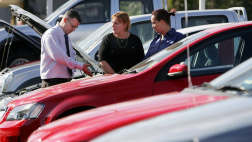More accurately, under its “Vision Zero” plan it proposes no fatalities in Volvo cars. This is the task that falls on the shoulders of Volvo's safety strategies manager, Jan Ivarsson, who runs the company's safety centre at Gothenburg.
“Yes, I think we can build the uncrashable car,” he says. “It has been acceptable that people die in cars. In the future, I don't think this attitude will be socially acceptable. You parallel that with aircraft accidents from frequent deaths in the earlier years to very low fatalities today. We no longer accept aircraft collisions.”
Last year, 1.2 million people died in car accidents around the world. The data — from intense research by Volvo, which it makes available to its parent company Ford — starts by isolating the actions of the driver.
“If you ensure the driver is awake, alert and sober, you have a very good start on the way to minimising car crashes,” Ivarsson says. “Then the driver must have information of the driving environment. This includes making the right road choice for the journey, staying in the right lane, travelling at the right speed, and so on.”
But humans can and do make mistakes. Here, Volvo sees that drivers need some assistance.
Clearly Ivarsson believes that to attain Volvo's ambitious “Vision Zero” crash-victim plan, the car will have to take over many driving tasks.
“Think of it like an auto-pilot in aircraft,” he says. “We would like to have the driver in the loop but in the future, it could be that it is the car that is in control. We make dynamic cars that are fun to drive and a lot of our customers thoroughly enjoy driving. But we recognise that a lot of things start with the driver's attitude and experience.
“We shouldn't forget that the factors involved in a crash, however, also involve authorities (road builders, government driver licensing departments, police, etc) and carmakers. We all have a role to play and a duty to perform to minimise car fatalities.”
So is Vision Zero workable by 2020? “It's very challenging,” Ivarsson says.
That aside, in its path towards Vision Zero, Volvo this week unveiled a raft of sophisticated safety features. Most will be encapsulated in the company's new compact crossover wagon, the XC60, which launches in Europe in October and Australia early next year. Some of the XC60's features are pointers to achieving Vision Zero.
The most radical is a low-speed crash avoidance system called City Safety. It will be standard equipment on the XC60, primarily because Volvo is concerned buyers will ignore it as an expensive and seemingly trite option.
Consisting of sonar hardware and algorithm-based software, City Safety prevents a car crashing into the back of another at speeds of less than 30km/h. Small fry? Not at all. Using data from 6.3 million police-reported crashes, Volvo found 29 per cent were rear-end prangs.
Within those crashes, a huge 75 per cent occurred at less than 30km/h. Put the two together and you see why Volvo is occupying its research and development — or a significant slice of it — at the lower end of the accidents.
The reason is that such crashes are expensive to repair, costly when added to time spent by vehicle owners, expensive to administer and police, and perhaps more importantly, can cause injury through whiplash. City Safety eradicates all of that. It could even save the owner money.
Volvo, spurred by research by Australian car clubs that spelled out the very high cost of low-speed crashes, is now in discussions with Australian insurance companies. It is quietly confident that owners of Volvo XC60 models can, from next year, get significant premium discounts at selected insurers.
Volvo is the first company to devise the system and, after protecting its investment for the next 12 months, will then offer it to other carmakers.
It will also roll it out to other Volvo models, and into the Ford group.
“It is a very important safety feature,” says Ivarsson. “It rates alongside our other world firsts, starting with the three-point seatbelt in 1959, the catalytic converter with lambda sond (oxygen sensor) in 1976, the seat whiplash system and inflatable curtain airbag, both in 1998. It also reflects our shift from passive safety to preventative safety — it's all about getting it right before the crash.”
Volvo officially unveiled the XC60 this month claiming it is “the safest Volvo ever.”
This is a car for the family that has all the high-end luxury features in a nimble, attractive package. Though it appears to hit the spot, it soon won't be alone in its market segment.
It will rival upcoming compact luxury SUVs including the Volkswagen Tiguan, Audi Q5, new BMW X3, Mercedes-Benz GLK and even a baby Lexus. The market already has the Mazda CX-7, Toyota Kluger, Ford Territory, Nissan Murano and others, so there's plenty of choice.
It is 20mm shorter than its sister, the XC70, and lower than its bigger sister, the XC90.
It's quite heavy, with a range of 1825kg to 1990kg depending on the model and the fittings, which is on par with the XC70.
There will be three engines, starting at the top with Volvo's three-litre in-line six-cylinder turbocharged T6 petrol unit.
There are also two five-cylinder turbocharged diesels; the D5 with 136kW and 400Nm and the 2.4-litre 2.4D, with 120kW and 340Nm.
There is no four-cylinder option and none will be offered in the near future. However, Volvo says it will launch a hybrid within five years, which is likely to use a four-cylinder engine and be inserted into an SUV model.
How a sensor will stop you crashing
City Safety is obvious externally only by the peepholes at the centre top of the windscreen. These give the laser sensors their view of the road ahead and can detect vehicles and other objects up to 10m from the car's front bumper.
The sensors use a complex computer software program that has access to the car's brakes, therefore overriding the driver. At its safety centre south of Gothenburg on Sweden's wintry west coast, the demonstration involved an inflatable “car” parked ahead of the test car — you can't be too sure about new technology.
You are told to pretend you are in traffic and to drive forward at 30km/h, which is surprisingly fast, and aim for the 'car.'
Closer and closer, I'm desperately preventing a jump on to the brake pedal. At a point that feels too late to stop, the brakes suddenly grip hard. The noise of the system as it engages its ABS brake system shocks me. Combined with the sudden stop, I'm quickly alert and move my foot to depress the brake pedal.
The system will only hold the car for 1-2 seconds, figuring correctly that I'm now awake. The abruptness and noise is deliberate.
It stops the car quickly and ensures the driver knows exactly what's going on. If it was a graduated process, I'm told, the driver would become complacent.
It will be standard on the XC60 early next year and other Volvos later.
Snapshot
Volvo XC60
On sale in Australia: March 2009
Price: TBA — expected in the $49,000-$62,000 range
Engine: T6 3L/6-cylinder turbo 210kW/400Nm; 2.4L/5-cyl turbo-diesel D5 136kW/400Nm, 2.4L/5-cyl 2.4D 120kW/340Nm
Economy: 0-100km/h: 7.5sec (T6); 9.9sec (D5); 10.9sec (2.4D)
Volvo XC60 2009: D5 2.4
| Engine Type | Diesel Turbo 5, 2.4L |
|---|---|
| Fuel Type | Diesel |
| Fuel Efficiency | 8.5L/100km (combined) |
| Seating | 5 |
| Price From | $6,930 - $9,790 |
| Safety Rating |
|








.jpg)
.jpg)







.png)











.jpg)